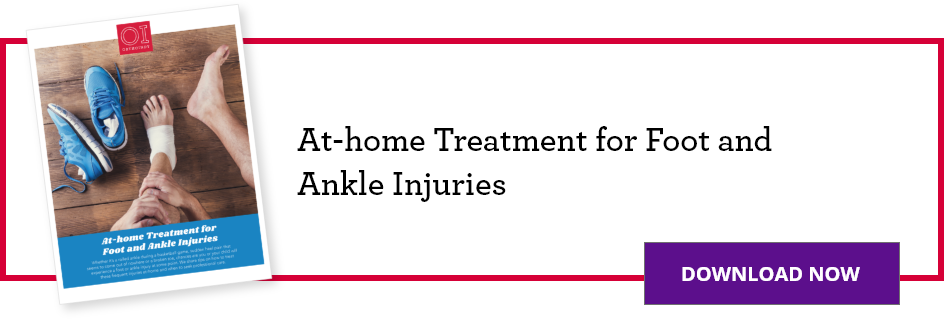THIS POST IS PART OF THE ULTIMATE GUIDE TO FOOT AND ANKLE INJURIES
Even a seemingly minor foot or ankle injury can be painful and limit your daily activities. In some cases, pain will go away over time with at-home treatment, but other times it can be difficult to determine whether or not you should seek help from a doctor.
According to Dr. Tim Weber, an OrthoIndy foot and ankle specialist and trauma surgeon it all comes down to the amount of pain you’re in and your mobility level. “If you’re in significant pain or you’re unable to put any weight on your foot or ankle, you should visit an urgent care or emergency room right away,” said Dr. Weber.
In fact, Dr. Weber says ignoring pain or trying to “tough it out” could make things worse. “If pain or mobility issues are serious, the best thing you can do is seek treatment from a doctor to avoid making the injury worse and prolonging your treatment.”
When should I go to the doctor for a foot injury?
It can be difficult to determine when to see a doctor for foot pain especially if pain isn’t consistent such as with injuries like plantar fasciitis or heel pain.
Go to an urgent care or ER for foot pain if:
- You have severe pain and swelling
- You are unable to walk or put weight on your foot
- Have an open wound (Emergency room only)
- Have signs of infection such as redness, warmth or tenderness (Emergency room only)
Schedule an appointment with a foot doctor if:
- You have swelling that is persistent for two to five days even with at-home treatment
- Have persistent pain or occasional pain flare ups after activity for several weeks
- You are experiencing numbness or tingling in your foot
How can I treat my foot injury at home?
“If your foot pain is related to overuse or is a mild injury where pain flares up occasionally, rest, ice and nonsteroidal anti-inflammatory drugs, such as aspirin, can often help relieve pain,” said Dr. Weber. “Avoid activities that worsen your foot pain and put ice on your foot for 20 minutes at a time, several times throughout the day.”
Over-the-counter anti-inflammatory medications (NSAIDS) such as ibuprofen or aspirin will help relieve pain and swelling.
When should I be concerned about ankle pain?
Even a relatively minor ankle injury can be extremely painful and make it difficult to get around. When should you go to the doctor for a sprained ankle or ankle pain?
“Ankle sprains can be just as painful as a broken ankle. It’s not so much about the specific injury determining when you should seek treatment as it is about the amount of pain you are in and if you can put weight on it,” said Dr. Weber.
Go to an urgent care or ER for ankle pain if:
- You have severe pain and swelling
- You cannot put weight on your foot
- You have an open wound (Emergency room only)
- You have signs of an infection such as redness, warmth and tenderness (Emergency room only)
Schedule an appointment with an ankle doctor if:
- You have persistent pain that doesn’t improve after a few weeks
- You have persistent swelling that doesn’t improve after two to five days of at-home treatment
How can I treat my ankle injury at home?
Swelling and bruising are a natural response to an ankle injury as your body rushes blood to the affected area to help heal it. Even with the swelling, many ankle injuries can be treated at home and most ankle sprains will typically heal on their own between two and 12 weeks.
- Rest: Keep weight off your ankle as much as possible.
- Ice: For 20 minutes each time, several times a day.
- Compression: Use a compression bandage or ankle wrap to reduce swelling.
- Elevation: Elevate your foot above the level of your heart whenever possible (toes above the nose).
- Over-the-counter pain medication: Ibuprofen and aspirin can help ease pain and aid healing.
“Even with the best care for an ankle injury, you may still experience swelling, stiffness or pain for several weeks after an ankle injury,” said Dr. Weber. “The stiffness may be particularly bad on mornings after you were active the day before.”
When should I go to the doctor for a broken toe?
“Unless you have an open wound or significant deformity, a broken toe isn’t a reason to make a trip to an emergency room or urgent care,” said Dr. Weber. “However, if you think you have a broken toe, it’s best to have a doctor look at it, even though you can treat it yourself at home. A broken toe can lead to more serious problems like infection, arthritis or long-term foot pain.”
In most cases, you will be sent home with directions for at-home treatment such as icing, buddy taping and over-the-counter pain medications. Most times, a broken toe will heal in four to six weeks.
To schedule an appointment with Dr. Weber, please call 317.917.4369 or learn more about foot and ankle treatment at OrthoIndy.
Schedule an appointment
Your well-being is important to us. Click the button below or call us to schedule an appointment with one of our orthopedic specialists. If your injury or condition is recent, you can walk right into one of our OrthoIndy Urgent Care locations for immediate care. For rehabilitation and physical therapy, no referral is needed to see one of our physical therapists.






